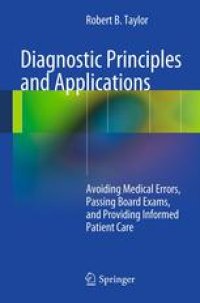
Ebook: Diagnostic Principles and Applications: Avoiding Medical Errors, Passing Board Exams, and Providing Informed Patient Care
Author: Robert B. Taylor (auth.)
- Tags: General Practice / Family Medicine, Primary Care Medicine, Medicine/Public Health general
- Year: 2013
- Publisher: Springer-Verlag New York
- Edition: 1
- Language: English
- pdf
This book fills the need for a resource presenting important diagnostic facts that clinicians should have learned during their classroom lectures and subsequent clinical training, but often didn’t. The content will be literature-based information that can help the clinician avoid diagnostic errors. Most other diagnosis books on the market are either “physical diagnosis” texts targeting student readers or “differential diagnosis” books intended for use by practicing physicians, though both types of books aim to be comprehensive. What sets this book apart from other diagnosis books is that it is a curated collection of facts, tailored specifically to address common gaps in clinical knowledge and describe less-traveled pathways to important diagnostic destinations. This book focuses on high-impact techniques. Essential Diagnostic Facts Every Clinician Should Know contains: -Classical diagnostic pearls clinicians should have learned in physical diagnosis courses. For example, a patient with acute pericarditis may find that leaning forward relieves the pain. -Red flag symptoms of serious disease. For example, an infant that tastes salty when kissed might be the first clue to a diagnosis of cystic fibrosis. -Pathognomonic signs allowing an occasional early diagnosis: For example, Koplik spots in a febrile child are found only with measles. -Plastic pearls exposed: For example, contrary to clinical lore, back pain at night has not been found to be a useful indicator for serious spinal pathology. -Counterintuitive clinical manifestations: For example, the patient with gout may have a normal or even low serum uric acid level during an acute attack. -Clinical manifestations that may point to uncommon diagnoses: For example, nocturnal bone pain, sometimes dramatically relieved by aspirin, characterizes osteoid osteoma.
Which disease should you consider when a young adult has localized bone pain that is dramatically relieved by aspirin? What is sometimes the only physical manifestation of bulimia nervosa? These so-called "old fashioned" historical clues and physical signs are not only part of our medical heritage; their deployment can often spell the difference between prompt clinical diagnosis versus a costly investigative odyssey. Often overlooked with today's emphasis on laboratory testing, a diagnostic pearl such as knowing that a diabetic patient with peripheral neuropathy may actually have metformin-induced vitamin B12 deficiency can be a shortcut to disease recognition.
Diagnostic Principles and Applications presents selected literature-based facts and diagnostic insights to help clinicians provide better-informed clinical assessments, avoid medical misadventures, and prepare for their board examinations. The chapters cover:
- Classic diagnostic pearls
- Red flag symptoms and signs of serious illness
- Bellwether disease indications allowing an occasional early, preemptive diagnosis
- Counterintuitive clinical manifestations of disease
- Curious clues to specific diagnoses
Robert B. Taylor, MD is the author and editor of more than two dozen medical books, including three on the topic of clinical diagnosis, and several hundred published articles. He is a veteran of both rural private practice and chairmanship of a medical school clinical department.